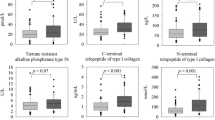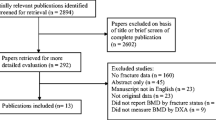Abstract
Background
The incidence of fractures is substantially increased in patients with chronic kidney disease (CKD) compared to the general population. The factors associated with increased bone fracture in this population are not well understood. Vitamin D deficiency has been associated with decreased bone mass and higher incidence of fractures in the general population. In this study, we aimed to assess the association between fracture and vitamin D status and other factors potentially associated with fracture in patients on maintenance hemodialysis.
Methods
One hundred and forty-four patients were assessed and interviewed about previous low-trauma fractures. Evidence of fracture was obtained from medical records and also through patient interviews. Routine laboratory results were collected from medical records. Serum intact PTH (iPTH) and 25(OH) vitamin D3 were measured. All patients underwent bone densitometry of the lumbar spine, femoral neck and distal radius. Bone quality was also assessed with quantitative bone ultrasound (QUS). Descriptive statistics, logistic regression models were used to analyze factors associated with fractures.
Results
One hundred and thirty patients were included in the final analysis. Patients with fractures (n = 21) had lower 25(OH) vitamin D3 levels (15.8 nmol/l (interquartile range, IQR: 27) vs. 30.0 nmol/l (IQR: 28.5), P = 0.029), were more likely females, had longer duration of end-stage kidney disease, and lower bone mineral density (BMD) at the distal radius. QUS parameters were not associated with fractures. Multivariate analyses revealed that serum 25(OH) vitamin D3 concentration, BMD at the radius, iPTH less than 100 pg/ml and history of fractures were independent predictors of new bone fracture after the initiation of dialysis therapy.
Conclusion
Increased bone fragility in dialysis patients is associated with vitamin D deficiency and relative hypoparathyroidism in addition to reduced BMD at the radius. Further studies are needed to determine whether patients with vitamin D deficiency benefit from vitamin D supplementation to reduce fracture risk.

Similar content being viewed by others
References
Alem AM, Sherrard DJ, Gillen DL et al (2000) Increased risk of hip fracture among patients with end-stage renal disease. Kidney Int 58:396–399
Jadoul M, Albert JM, Akiba T et al (2006) Incidence and risk factors for hip or other bone fractures among hemodialysis patients in the dialysis outcomes and practice patterns study. Kidney Int 70:1358–1366
Mittalhenkle A, Gillen DL, Stehman-Breen CO (2004) Increased risk of mortality associated with hip fracture in the dialysis population. Am J Kidney Dis 44:672–679
Jamal SA, Hayden JA, Beyene J (2007) Low bone mineral density and fractures in long-term hemodialysis patients: a meta-analysis. Am J Kidney Dis 49:674–681
Lacativa PG, de Mendonca LM, de Mattos Patricio Filho PJ et al (2005) Risk factors for decreased total body and regional bone mineral density in hemodialysis patients with severe secondary hyperparathyroidism. J Clin Densitom 8:352–361
Ambrus C, Almasi C, Berta K, et al (2010) Bone mineral density and parathyroid function in patients on maintenance hemodialysis. Int Urol Nephrol. doi:10.1007/s11255-009-9702-2
Danese MD, Kim J, Doan QV et al (2006) PTH and the risks for hip, vertebral, and pelvic fractures among patients on dialysis. Am J Kidney Dis 47:149–156
Atsumi K, Kushida K, Yamazaki K et al (1999) Risk factors for vertebral fractures in renal osteodystrophy. Am J Kidney Dis 33:287–293
Coco M, Rush H (2000) Increased incidence of hip fractures in dialysis patients with low serum parathyroid hormone. Am J Kidney Dis 36:1115–1121
Urena P, Bernard-Poenaru O, Ostertag A et al (2003) Bone mineral density, biochemical markers and skeletal fractures in haemodialysis patients. Nephrol Dial Transplant 18:2325–2331
Yamaguchi T, Kanno E, Tsubota J et al (1996) Retrospective study on the usefulness of radius and lumbar bone density in the separation of hemodialysis patients with fractures from those without fractures. Bone 19:549–555
Bischoff-Ferrari HA, Willett WC, Wong JB et al (2009) Prevention of nonvertebral fractures with oral vitamin D and dose dependency: a meta-analysis of randomized controlled trials. Arch Intern Med 169:551–561
Tomida K, Hamano T, Mikami S et al (2009) Serum 25-hydroxyvitamin D as an independent determinant of 1–84 PTH and bone mineral density in non-diabetic predialysis CKD patients. Bone 44:678–683
Cranney A, Weiler HA, O’Donnell S et al (2008) Summary of evidence-based review on vitamin D efficacy and safety in relation to bone health. Am J Clin Nutr 88:513S–519S
Bischoff-Ferrari HA, Dawson-Hughes B, Staehelin HB et al (2009) Fall prevention with supplemental and active forms of vitamin D: a meta-analysis of randomised controlled trials. BMJ 339:b3692
Mucsi I, Almasi C, Deak G et al (2005) Serum 25(OH)-vitamin D levels and bone metabolism in patients on maintenance hemodialysis. Clin Nephrol 64:288–294
Fournier A, Fardellone P, Achard JM et al (1999) Importance of vitamin D repletion in uraemia. Nephrol Dial Transplant 14:819–823
Pfeifer M, Begerow B, Minne HW et al (2009) Effects of a long-term vitamin D and calcium supplementation on falls and parameters of muscle function in community-dwelling older individuals. Osteoporos Int 20:315–322
Jamal SA, Chase C, Goh YI et al (2002) Bone density and heel ultrasound testing do not identify patients with dialysis-dependent renal failure who have had fractures. Am J Kidney Dis 39:843–849
Inaba M, Okuno S, Kumeda Y et al (2005) Increased incidence of vertebral fracture in older female hemodialyzed patients with type 2 diabetes mellitus. Calcif Tissue Int 76:256–260
Jamal SA, Gilbert J, Gordon C et al (2006) Cortical pQCT measures are associated with fractures in dialysis patients. J Bone Miner Res 21:543–548
Grotz WH, Mundinger FA, Gugel B et al (1994) Bone fracture and osteodensitometry with dual energy X-ray absorptiometry in kidney transplant recipients. Transplantation 58:912–915
Patel S, Kwan JT, McCloskey E et al (2001) Prevalence and causes of low bone density and fractures in kidney transplant patients. J Bone Miner Res 16:1863–1870
Bauer DC, Gluer CC, Genant HK et al (1995) Quantitative ultrasound and vertebral fracture in postmenopausal women. Fracture intervention trial research group. J Bone Miner Res 10:353–358
Turner CH, Peacock M, Timmerman L et al (1995) Calcaneal ultrasonic measurements discriminate hip fracture independently of bone mass. Osteoporos Int 5:130–135
Moayyeri A, Kaptoge S, Luben RN et al (2009) Estimation of absolute fracture risk among middle-aged and older men and women: the EPIC-Norfolk population cohort study. Eur J Epidemiol 24:259–266
Gluer CC (1997) Quantitative ultrasound techniques for the assessment of osteoporosis: expert agreement on current status. The international quantitative ultrasound consensus group. J Bone Miner Res 12:1280–1288
Cadossi R, Cane V (1996) Pathways of transmission of ultrasound energy through the distal metaphysis of the second phalanx of pigs: an in vitro study. Osteoporos Int 6:196–206
Acknowledgments
This study was supported by grant from the ETT of the Ministry of Health (172/2006), the Hungarian Kidney Foundation and the Foundation for Prevention in Medicine. This paper was supported by the János Bolyai Research Scholarship of the Hungarian Academy of Sciences (Miklos Zsolt Molnar).
Author information
Authors and Affiliations
Corresponding author
Rights and permissions
About this article
Cite this article
Ambrus, C., Almasi, C., Berta, K. et al. Vitamin D insufficiency and bone fractures in patients on maintenance hemodialysis. Int Urol Nephrol 43, 475–482 (2011). https://doi.org/10.1007/s11255-010-9723-x
Received:
Accepted:
Published:
Issue Date:
DOI: https://doi.org/10.1007/s11255-010-9723-x




